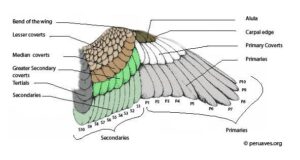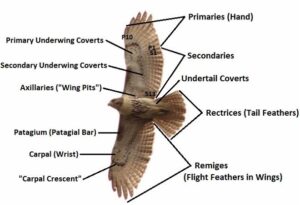Back to: ZOOLOGY 300 Level
Welcome To Class!
How are you doing today, my brilliant friend? I hope you’re ready for another amazing lesson. Have you ever wondered how birds manage to fly with such grace and power? Or why they have so many different types of feathers? Today, we’re going to talk about how feathers work, how they help birds fly, and why they’re much more than just decoration. Let’s go!
Feathers And Flight
Types and Functions of Feathers
Feathers are unique to birds — no other animal group has them. They are made of keratin (the same protein in your fingernails and hair) and are incredibly lightweight but strong.

There are different types of feathers, and each serves a specific purpose:
- Flight feathers: These are the large, stiff feathers found on the wings and tail. They provide lift and help with direction during flight. Think of them like the wings of an airplane.
- Contour feathers: These cover the body and give the bird its shape. They also protect the skin and help with waterproofing.
- Down feathers: These are soft and fluffy, found beneath the outer feathers. They trap heat and keep the bird warm — very useful for cold mornings in Jos or the Harmattan in Kano.
- Filoplumes and bristles: These are small, hair-like feathers that help with sensing movements and protecting the face and eyes.

Feathers also play a role in camouflage, courtship displays, and species recognition. For example, the colourful feathers of a peacock are used to attract mates, just like a beautifully dressed person at an owambe might catch your attention.
Structure of a Feather
A typical feather has a central shaft called the rachis, with fine branches called barbs. These barbs have tiny hooks called barbules that lock together like Velcro, making the feather smooth and strong.
If you’ve ever picked up a feather and tried to pull it apart, then smoothed it back together, you’ve seen this structure in action. It’s simple but brilliant.
How Feathers Help Birds Fly
Flight is possible because of a combination of feather structure, wing shape, and strong flight muscles.
Birds achieve lift by flapping their wings and pushing against the air. The shape of the wing, with a curved upper side and flatter underside, allows air to move faster over the top, creating lower pressure and lifting the bird upwards — a principle called aerodynamics.
Feathers increase the wing’s surface area and create the right conditions for smooth flight. The tail feathers act like a rudder, helping birds steer and balance in the air.
Different birds have wings and feathers adapted to their lifestyle:
- Eagles have broad wings for soaring over long distances.
- Hummingbirds have short, strong wings for hovering like a helicopter.
- Chickens, which don’t fly far, have rounded wings good for quick bursts.

Summary
- Feathers come in different types like flight, contour, and down feathers, each with a unique function.
- They are made of keratin and have a complex but effective structure for strength and lightness.
- Flight is made possible by feathers, wing shape, and strong muscles working together to lift and move birds through the air.
Evaluation
- Name and describe three types of feathers and their functions.
- How does the structure of a feather support flight?
- What role do tail feathers play during bird flight?
- Describe how the wings of an eagle and a hummingbird differ in their function.
Fantastic job, my friend! You’ve just uncovered the science behind something we see every day but may not always appreciate — feathers and flight. Just like birds take to the skies, your knowledge is lifting you higher. Keep showing up, keep learning — and remember, Afrilearn is proud to fly beside you on this journey. See you next class!
